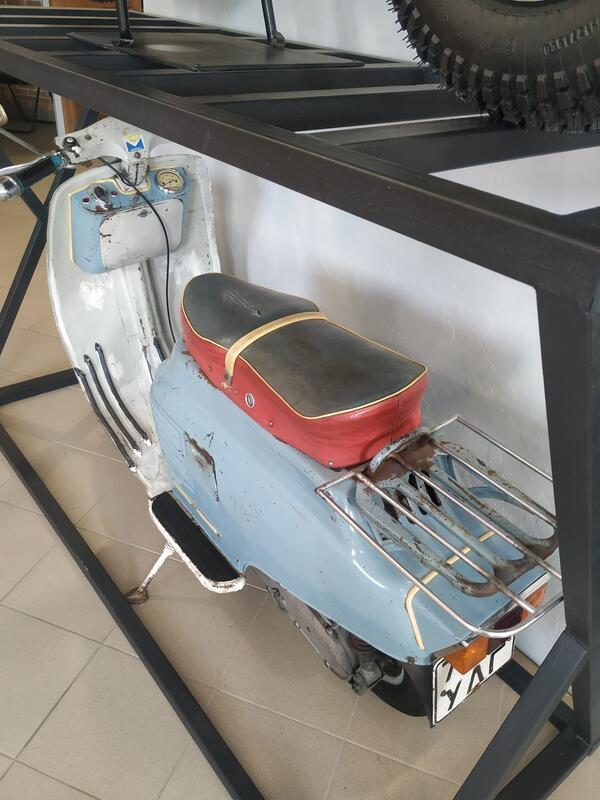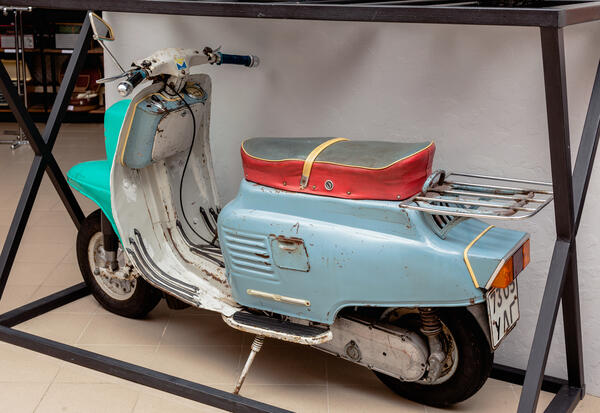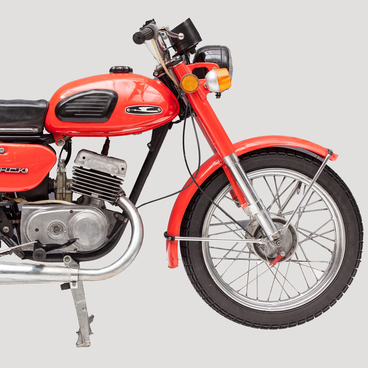The Vyatka VP-150M was the first Soviet scooter that was manufactured by the Vyatskiye Polyany Machine-Building Plant (VPMZ) between 1957 and 1966. It was a copy of the Vespa 150GS released in Italy in 1955. According to the plant’s official information, 290,467 scooters of this model were produced in the Soviet Union over a period of ten years. The Vyatka was a relatively quiet scooter with a noise level of 80 dB.
Its simple design eliminated the need for complicated adjustments. The VP-150M could run on the A-66 low octane gasoline. The Vyatka had few differences from its original Italian prototype: the designers replaced the inscription on the tag attached to the type plate and in 1960 added a red flag with a five-pointed star to the front fender.
Moreover, the Vyatka had a larger central element of the handlebar and the coupling of the headlight. Its speedometer was round instead of the oval Vespa version. On the Soviet scooter, the ignition switch was a separate device on the handlebar, and in the Italian version, it was hidden in the headlight body. The scooters also had slightly different sizes: the Vyatka was only four centimeters longer but seven kilograms heavier due to the use of thicker sheet metal.
The modified VP-150M version had an innovative design that was in line with contemporary trends. The only thing that remained unchanged was the stamping of the front section of the frame, but it could only be seen after removing the headlight and front fender.
The basic version of the scooter had an all-welded body made of stamped components, while in the updated model, only the front part was produced according to this principle, and the rear section was made of pipes welded together. This helped to improve the general ruggedness of the structure and reduce its weight. The front fender could no longer rotate, which improved the reliability of the scooter.
In the modified Vyatka, the headlight was mounted rigidly on the frame surface, which had an adverse effect on riding during the hours of darkness. Most likely, this decision was influenced by the designers who were guided by foreign fashion trends.
The VP-150M scooter had almost the same engine as its predecessor. It was a single-cylinder two-stroke air-cooled engine that ran on a mix of gasoline and engine oil.
Its simple design eliminated the need for complicated adjustments. The VP-150M could run on the A-66 low octane gasoline. The Vyatka had few differences from its original Italian prototype: the designers replaced the inscription on the tag attached to the type plate and in 1960 added a red flag with a five-pointed star to the front fender.
Moreover, the Vyatka had a larger central element of the handlebar and the coupling of the headlight. Its speedometer was round instead of the oval Vespa version. On the Soviet scooter, the ignition switch was a separate device on the handlebar, and in the Italian version, it was hidden in the headlight body. The scooters also had slightly different sizes: the Vyatka was only four centimeters longer but seven kilograms heavier due to the use of thicker sheet metal.
The modified VP-150M version had an innovative design that was in line with contemporary trends. The only thing that remained unchanged was the stamping of the front section of the frame, but it could only be seen after removing the headlight and front fender.
The basic version of the scooter had an all-welded body made of stamped components, while in the updated model, only the front part was produced according to this principle, and the rear section was made of pipes welded together. This helped to improve the general ruggedness of the structure and reduce its weight. The front fender could no longer rotate, which improved the reliability of the scooter.
In the modified Vyatka, the headlight was mounted rigidly on the frame surface, which had an adverse effect on riding during the hours of darkness. Most likely, this decision was influenced by the designers who were guided by foreign fashion trends.
The VP-150M scooter had almost the same engine as its predecessor. It was a single-cylinder two-stroke air-cooled engine that ran on a mix of gasoline and engine oil.




